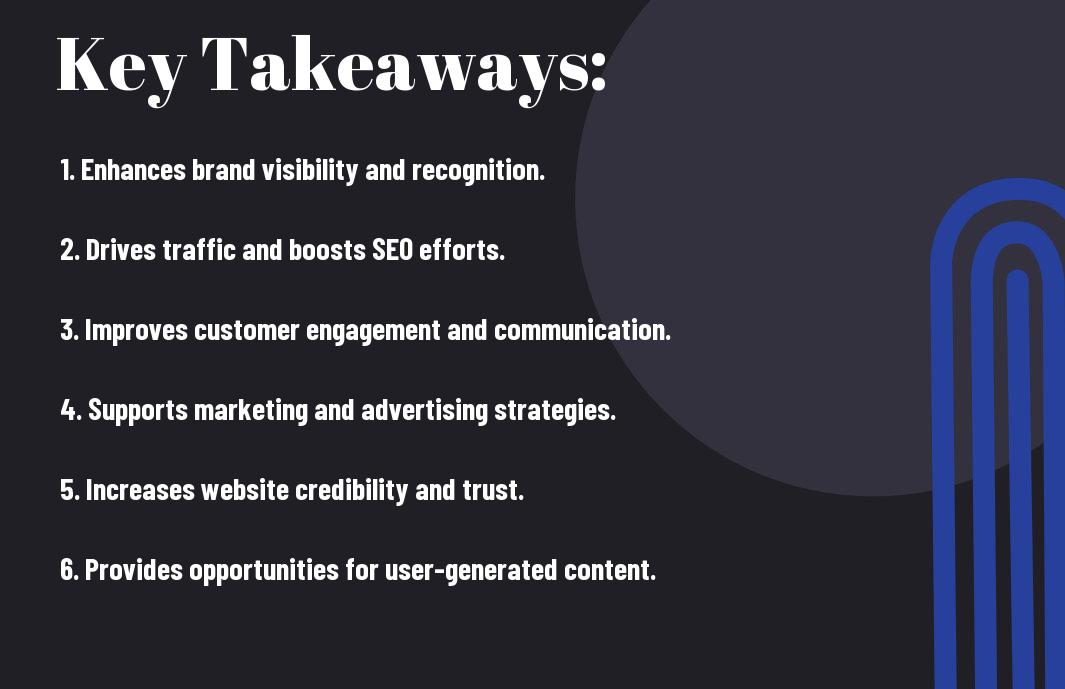The Importance Of Social Media Integration In Modern Website Design

The Importance Of Social Media Integration In Modern Website Design
March 27, 2024
10 Steps To Creating A Custom Website Design For Your Small Business
March 29, 2024Website Design plays a crucial role in today’s digital landscape, with social media integration standing out as a key component for success. Incorporating social media platforms into website design is no longer just an option but a necessity for businesses looking to thrive online. This blog post will probe into the benefits of social media integration, such as increased brand visibility, improved customer engagement, and enhanced user experience. We will also discuss the risks of neglecting social media integration, including reduced reach and missed opportunities to connect with a wider audience. Stay tuned to discover how integrating social media into your website design can elevate your online presence and drive business growth.
Key Takeaways:
- Social media integration is crucial in modern website design to enhance user engagement and reach a wider audience.
- Integrating social sharing buttons on websites allows visitors to easily share content, increasing the site’s visibility and driving traffic.
- Using social media feeds on websites can provide dynamic and real-time content updates, keeping visitors informed and engaged.

The Strategic Imperative of Social Media Integration
Clearly, integrating social media into website design is no longer optional in today’s digital landscape. To stay relevant and competitive, businesses must prioritize social media integration in their website design strategies. For important social media integration strategies for 2021, check out Important Social Media Integration Strategies For 2021.
Enhancing User Engagement
On many websites, social media integration is a key factor in enhancing user engagement. By incorporating social sharing buttons, live feeds, and user-generated content from platforms like Instagram and Facebook, websites can create a more interactive and dynamic experience for visitors. This can lead to increased time spent on site, higher click-through rates, and more meaningful interactions with the brand.
Expanding Brand Reach and Visibility
Expanding brand reach and visibility is crucial in today’s crowded online marketplace. By integrating social media into website design, businesses can extend their brand’s presence beyond their own website. Plus, by making it easy for visitors to share content on social platforms, brands can tap into the vast networks of their audience, reaching potential customers that they may not have been able to reach through traditional marketing efforts. This can result in increased brand awareness, website traffic, and ultimately, conversions.

Social Media Integration Techniques
Share Buttons and Social Login
Despite being small in size, social media share buttons play a significant role in driving traffic to your website. These buttons allow users to easily share content they find interesting with their social media networks, increasing your website’s reach and visibility. Additionally, implementing social login functionality simplifies the user experience by enabling visitors to log in using their social media credentials, eliminating the need to create a new account.
Social Feeds and User-Generated Content
Media
The use of social feeds on your website can provide real-time updates on social media activities related to your brand. By embedding feeds from platforms such as Instagram, Twitter, or Facebook, you can showcase user-generated content and increase engagement with your audience. User-generated content, such as reviews and testimonials, builds trust and credibility among potential customers, influencing their purchasing decisions.

Design Considerations for Seamless Integration
Aesthetic and Functional Harmony
Many modern websites strive for a seamless integration of social media by ensuring both aesthetic and functional harmony. Any successful integration should blend the design elements of the website with social media plugins in a visually appealing way that does not disrupt the overall user experience. This involves strategically placing social media icons, feeds, and sharing buttons in prominent yet unobtrusive locations.
Mobile-First Approach and Responsive Design
Many websites are now adopting a mobile-first approach and responsive design to cater to the increasing number of users accessing the internet via mobile devices. One of the key considerations for integrating social media seamlessly is ensuring that the social media elements are optimized for mobile viewing. Any website that prioritizes mobile users must ensure that social media integration does not compromise the site’s responsiveness or user experience across different devices.
Design your website with a focus on creating a visually pleasing and user-friendly interface that seamlessly incorporates social media elements. Ensure that social media integration enhances the overall user experience without overshadowing the main content of the website. Prioritize mobile optimization and responsiveness to cater to the diverse range of devices used to access your site.

Measuring the Impact of Social Media Integration
Analytical Tools and Metrics for Assessment
With the rise of social media integration in website design, it is crucial to have the right tools and metrics in place to assess its impact. Tools like Google Analytics, Hootsuite, and Sprout Social can provide valuable insights into how social media is driving traffic to your website, increasing engagement, and ultimately impacting your bottom line.
Adapting Strategies Based on User Data and Feedback
Media integration allows businesses to adapt their strategies based on user data and feedback received through social media channels. By analyzing metrics such as click-through rates, bounce rates, and conversion rates, businesses can tailor their content and messaging to better resonate with their target audience, ultimately improving their overall social media presence. It is imperative for businesses to listen to their audience and make necessary adjustments to stay relevant in a constantly evolving digital landscape.
Challenges and Best Practices
Unlike many other aspects of website design, social media integration presents unique challenges and opportunities. To probe deeper into this topic, you can read more about the Importance of Social Media Integration in Website Design.
Maintaining Brand Consistency
On the journey of integrating social media into your website, one of the key challenges is maintaining brand consistency across all platforms. Your website should reflect the same tone, style, and messaging as your social media profiles to ensure a cohesive brand experience for your audience.
Navigating Privacy and Security Concerns
Security concerns often arise when integrating social media into websites. It is crucial to address and navigate these issues to protect both your brand and your users. For instance, ensuring secure data transmission, implementing two-factor authentication, and regularly updating security protocols are necessary steps in safeguarding against potential threats.
To wrap up
Now, it is clear that social media integration is crucial in modern website design. By incorporating social media platforms into websites, businesses can enhance their online presence, engage with their audience, and drive traffic to their websites. This integration also helps in building brand credibility, increasing brand awareness, and improving search engine optimization. In today’s digital age, having a strong social media presence is necessary for any business looking to stay competitive and reach a wider audience. Therefore, integrating social media into website design should be a top priority for businesses looking to succeed in the online landscape.
FAQ
Q: Why is social media integration important in modern website design?
A: Social media integration allows websites to leverage the power of social platforms to reach a wider audience, increase brand visibility, and engage with users on a more personal level.
Q: How does social media integration benefit a website’s SEO?
A: By integrating social media into website design, it can lead to increased website traffic, improved search engine rankings, and better online visibility due to social signals and backlinks.
Q: What are some key elements of effective social media integration in website design?
A: Key elements include prominently displayed social sharing buttons, real-time social media feeds, social login options, and seamless integration with social media profiles.
Q: How can social media integration enhance user engagement on a website?
A: Social media integration allows users to easily share website content, interact with the brand on social channels, and participate in discussions, contests, and promotions, leading to higher engagement levels.
Q: What are some popular social media platforms that are commonly integrated into modern website design?
A: Some popular social media platforms for integration include Facebook, Twitter, Instagram, LinkedIn, Pinterest, and YouTube, depending on the target audience and nature of the website.


